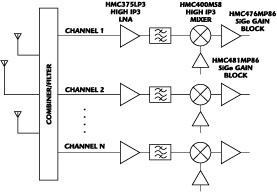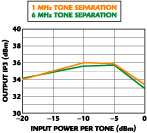Cover Story
Electronically Tunable Thin Film Filters for Microwave Applications
Paratek Microwave Inc.
Columbia, MD
Interference in wireless systems increases bit error rate (BER) and decreases the reliability and quality of service of the communication network. Interference mitigation requires filtering of the transmitted and received energies to reject all unwanted frequencies. As more signals are packed closer together in the available bandwidth, filters must become more selective and more universal at the same time. This is where fixed frequency filters reach their limitations. As the traffic increases and the bandwidth is more efficiently utilized, in-band interference is virtually guaranteed unless the passband of each filter is reduced closer to that of the channel. If fixed filters are used, a unique filter is required for each channel, and the radio loses flexibility and increases in cost.
|
|
|
Fig. 1 A 16 QAM radio's (a) ideal constellation diagram and (b) the effect of group delay and amplitude variations. |
Of equal importance to the BER is the group delay variation of the signal over frequency, which causes phase distortion of the signal. This can limit the ability of the radio to be used in higher order modulation schemes that allow more data bits to be packed into the same bandwidth and increase capacity. In higher modulation schemes, such as 128 QAM or 256 QAM, the phase and amplitude states are more closely packed. Therefore, there is less space between the adjacent states, making it more difficult to distinguish between them. This concept is illustrated in Figure 1 .1 Image 1a shows an ideal constellation plot for a 16 QAM radio. There is no amplitude or phase distortion and every sample from each particular state overlays in exactly the same position so that the states are clearly defined. The effects of group delay and amplitude variations are shown in Image 1b. Each sample for a given state is slightly offset from the ideal position so that the states are smeared and indistinguishable. The effect is significantly worse for the higher modulation rates.
A filter that can tune a narrow passband over multiple frequency bands, and have minimal group delay and amplitude variation will significantly enhance the performance of radios. Moreover, if such a filter is electronically tunable then it can be operated in either an open loop or closed loop to accommodate all variations over temperature as well as over the lifetime of the radio.
A new line of electronically tunable RF (ETRF™) filters has been developed for radio applications, including the first down conversion stage in point-to-point and point-to-multipoint radios. This filter has a narrow instantaneous bandwidth for high discrimination of unwanted frequencies, and the ability to tune across a broad range of frequencies. The design, construction, performance and applications of this filter at 2 GHz will be described. The basic filter has a four-pole, elliptic frequency response with two transmission zeroes for high rejection at the image frequencies. The bandwidth of the filter is approximately 50 MHz at any desired center frequency within the tuning range of the filter. The tuning range is approximately 15% of the nominal frequency. Center frequency tuning is provided by a variable capacitance in the resonator structure that is the result of the Parascan™ electronically tunable dielectric materials. These materials are low cost ceramics that may be optimized for the specific requirements of the component. They have the unique ability to change their dielectric constant by application of a DC bias voltage while drawing very little current (mA).
The voltage field is provided by a remotely addressable controller that only requires a 5 to 12 VDC power supply and a tuning command from the radio. The tuning command may be a digital logic word or an analog voltage between 0 and 12 V. The controller requires approximately 400 mW maximum, of which about half is used to power the logic circuits required for digital, open loop control. In this mode, the filter is controlled by a digital command from the radio's controller, or it may be preset by electronic command to a particular frequency prior to installation. It provides excellent frequency accuracy and repeatability so that the filter may be set to any predetermined frequency value. The number of selectable frequencies is specified by the customer and is a function only of the number of bits implemented in the controller, as the filter itself is continuously tunable. The controller ensures thermal stability of the frequency in the open loop control mode by sensing the temperature of the filter and making an appropriate adjustment of the tuning voltage applied to the material.
|
|
|
Fig. 2 The ETRF filter's amplitude characteristics. |
The filter can also operate in a closed loop mode, where the filter may be locked to a desired center frequency in much the same way that a voltage-controlled oscillator is locked to a frequency. In this case, the radio may sense either the amplitude of the filtered signal or the center frequency of the passband and automatically adjust the tuning voltage to the controller in case of drift or if the radio is ever operated at a different frequency. Because the drift is quite slow (on the order of seconds) in most applications, this closed loop sampling can take place at a very slow rate (in the order of 1 Hz or less) with little effect on system overhead.
The amplitude characteristics of the filter are illustrated in Figure 2 for the minimum, median and maximum frequency settings. The filter electronically tunes over a frequency band of 2000 to 2300 MHz with a maximum insertion loss of 5.5 dB and greater than 35 dB of rejection at 140 MHz offset from the center frequency. One benefit that is not immediately clear from this plot is that the filter has a narrow instantaneous passband to provide high frequency discrimination to nearby frequencies and has a broad tuning range so it can cover many more channels than broadband filters.
|
|
|
Fig. 3 The ETRF filter's group delay variation at (a) 2.00, (b) 2.15 and (c) 2.30 GHz. |
The ETRF filter maintains exceptionally low group delay variation over its full tuning range. Figure 3 shows the group delay variation at the 2000, 2150 and 2300 MHz frequency settings. At less than 2 ns for the parabolic and less than 0.5 ns for the linear group delay, this performance is at least an order of magnitude better than currently used filter technologies in commercial microwave radios. Table 1 shows the specifications of the ETRF filters at 2000 to 2300 MHz.
The basic filter design has much broader application than simply center frequency tuning or repositioning of the filter. Variable bandpass filters are also possible from this approach where the passband width is varied about a fixed center frequency. An extension of this design takes advantage of the excellent group delay properties to realize electronically tunable delay filters for multi-channel power amplifiers (MCPA) that utilize the feedforward approach for carrier cancellation.
MCPAs combine several different signals and amplify them simultaneously. During this amplification, multiple signals generate intermodulation products that will degrade the performance of the MCPA and increase the BER. The cancellation technique in a feedforward amplifier includes a series of sampling and inversion steps that minimizes the noise from the spectrum with little impact on the carrier signal.
A key requirement in this process is a precision time delay that delivers the sampled signal to the output at exactly the same time as the main signal so that they cancel leaving only the carriers. To date, fixed delay lines have been used that are manually tuned to a precise delay value at installation. Once set, fixed delay lines have no ability to adjust for environmental or lifetime effects of the amplifier allowing cancellation to degrade and noise to increase. The amplifiers may use electronically controlled, digital phase shifters to help mitigate this, but in addition to the extra cost and insertion loss, they may only provide a limited number of discreet phase settings. More phase settings proportionally drive loss. Additional drawbacks are variation of group delay and phase over frequency, and limited power handling.
Delay filters offer several distinct advantages over conventional delay lines fabricated from coaxial cable. They are smaller, easier to install (when realized in surface-mount technology) and can be integrated with other functions. Yet these fixed delay filters do not ensure that the feedforward amplifier can adapt to meet the performance requirements over time for all environmental conditions. To achieve that, the loop needs to be adaptive, or at least tunable.
The ETRF delay filters offer continuous tuning over a range of delay values. This tuning is beneficial first during the assembly and test phase of the MCPA because the delay filter can be electronically tuned to the exact value required to optimize intermodulation distortion (IMD) cancellation. Secondly, it can be automatically tuned throughout the amplifier's life to compensate for changes in the circuit.
|
|
|
|
Fig. 5 The group delay filter's tuning range. | |
|
| |
|
Fig. 4 The ETRF delay filter's amplitude and phase response at delay settings of (a) 2.6, (b) 2.9 and (c) 3.2 ns. |
Fig. 6 The ETRF delay filter's figure of merit. |
The ETRF delay filters have low losses and flat responses over frequency. They continuously tune more than 20 percent from 2.6 to 3.2 ns while maintaining excellent amplitude and phase ripple. Figure 4 shows the amplitude and phase response of the ETRF delay filter for delays of 2.6, 2.9 and 3.2 ns. Figure 5 shows the delay as a function of frequency for each of those conditions, while Figure 6 shows a figure of merit plot for delay lines.2 This figure of merit represents the equivalent cancellation of an amplifier with the same overall phase and amplitude ripple as the delay line. The figure of merit is important because it illustrates that the cancellation is a function of the combination of the two parameters at each point rather than the worst-case values that may appear at different frequencies.
|
| ||||||||||||||||||||||||||||||||||||||||||||||||||||||
The specifications for the ETRF delay filter are shown in Table 2 . This product may also be controlled in either a closed or open loop.
The future of the ETRF filter technology is very bright. Modified topologies of its design may be used to enable multi-band radios, enable higher or variable capacity radios or provide true, variable time delay for highly linearized amplifiers. This breadth of applicability ensures that these tunable products will become a mainstay of the communication architecture.
|
|
|
Fig. 7 ETRF module schematic. |
In addition, it is apparent that these discreet ETRF components can be integrated into higher functionality modules. For example, Figure 7 shows the concept of an ETRF module that includes an ETRF voltage tunable oscillator (VTO) along with the tunable filter. In addition to performance improvements in tuning range, insertion loss, phase linearity and amplitude ripple, these tunable IF filters are being developed for other frequency ranges and applications. Units are available with custom interfaces and packaging according to the radio OEM's needs. Additional information on ETRF filters and ETRF products such as tunable diplexers, delay lines, oscillators and electronically scanning antennas can be obtained from the company's Web site at www.paratek.com or via e-mail at etrf@paratek.com.
References
1. R.G. Winch, Telecommunication Transmission Systems , McGraw Hill, New York, NY, 1993, p. 101.
2. N. Pothecary, Feedforward Linear Power Amplifiers , Artech House Inc., Norwood, MA, 1999, pp. 130-135.
Paratek Microwave Inc., Columbia, MD (443) 259-0140.
Circle No.300







